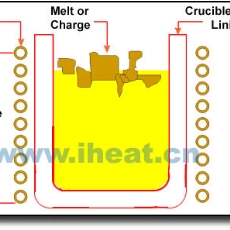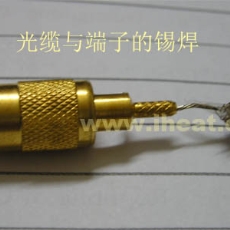FAQ
Views
What is induction heating?
The heating method known as induction heating occurs when an electrically conductive material is placed in a varying magnetic field. Induction heating is a rapid form of heating in which a current is induced directly into the part being heated. Induction heating is a non-contact form of heating.Can you braze glass or ceramics with induction?
If you work with glass or ceramics, a compact vacuum furnace is a great solution for brazing. You'll get quick, clean heat with very precise temperature control.What makes up a typical induction heating system?
A typical induction heating system consists of the induction heating power supply, an induction heating coil, and a water-cooling source, which cools the coil and several internal components inside the power supply. The induction heating power supply sends alternating current through the induction coil, thus generating a magnetic field. When a work piece is placed within the coil and enters the magnetic field, eddy currents are induced within the workpiece, generating precise and localized heat without any physical contact between the induction coil and the work piece.What is an induction heating coil (inductor)?
The varying magnetic field required for induction heating is developed in the induction heating coil via the flow of AC (alternating current) in the coil. The coil can be made in many shapes and sizes to custom fit a specific application. The coils can range from tiny coils made of copper tubing used for precise heating of extremely small parts in applications such as soldering and ferrule heating to large coil assemblies of copper tubing used in applications such as strip metal heating and pipe heating.Will induction heating increase my utility bills?
Not likely. Induction heating is a very effective, efficient means of heating. Most of our customers who are switching to induction for the first time see their utility bills go down.What are typical utility requirements for induction?
Of course it depends on the system, but a typical typical system requires 380, 3-phase VAC at 50 Hz and 30 Amps. Also figure on 80 PSI compressed air and 40 PSI water at 4 gallons per minute for cooling.Is this joint suitable for induction brazing?
Our team of metallurgical and mechanical engineers will be glad to have a look at your parts and process and give you our best advice - no obligation!What is the importance of the induction heating coil (inductor)?
The induction coil design is one of the most important aspects of an induction heating system. The coil is a custom design to give your work piece or part the proper heating pattern, maximize efficiency of the induction heating power supply’s load matching system, and to accomplish these tasks while still permitting ease of loading and unloading your part.How can my process benefit from induction heating?
Induction heating can benefit your process in a number of ways. Induction heating is highly repetitive once initial adjustments are made to the power supply. Following this phase, part after part can be heated with identical results so long as the parts are introduced to the coil similarly each cycle. This can also lead to better material utilization and product yield. Induction heating can reduce or eliminate the need for skilled operators in application such as brazing and soldering. The ability of induction heating to heat all parts identically lends itself to automation of the process. Induction heating can also heat the part in a highly localized fashion, which can be extremely beneficial when it is desirable or necessary to limit the heat to only a certain region of the part.How does induction heating equipment compare to other heating sources?
In addition to some of the points mentioned in the previous FAQ, induction heating is also a clean form of heating which does not emit unpleasant odor or heat. Because the current is induced directly into the part being heated, there is no radiant heating effect into a facilities ambient environment. The location of the desired heat zone can be defined to a specific area on a workpiece in order to achieve accurate and consistent results. Induction heating equipment is instantly on which means it requires no warm-up time as other conventional heating sources do. Induction heating systems are extremely energy efficient.What is the importance of a power supplies power rating and frequency?
The power rating determines the speed at which a workpiece can be heated. The frequency, along with the electrical resistivity of the workpiece and relative magnetic permeability, determines the skin depth of the eddy currents induced into the work piece. In surface heating, the power rating also plays an important role in skin depth. The higher the frequency, the more shallow the skin depth and the lower the frequency, the deeper the skin depth. Therefore, higher frequencies are more effective for heating smaller parts or parts that require shallow heat penetration, while lower frequencies are more effective for larger materials with deeper heat penetration requirements.How do I select a braze alloy?
We've put together a Brazing Alloy Selection Guide to help you choose the best option. It depends on the composition of your part, how and where it will be used, and the joint strength required. Another helpful service we provide for our customers is to put them in touch with an experienced braze alloy supplier.We've been running these old vacuum furnaces for years. How can we set up a leaner operation?
The best thing you can do is unplug those old furnaces and invest in a quick, clean vacuum induction system. Our new compact induction vacuum furnace will fit right into your manufacturing cell.What are some of the other advantages to using Induction Heating?
Fast Cycle Times – With induction heating technology, heat is produced instantly and directly within the part being heated. Thus heat can be supplied as quickly as a material will permit it, eliminating typical soak times associated with radiation or convection heat technologies.Accurate Heat Zones - Through the development of an induction coil combined with the specification of the proper power and frequency, the can isolate or pinpoint a heat-zone, small or large without affecting surrounding areas. The result is minimal distortion in part being heated, yielding higher quality production. Additional infrared temperature control devices can also be added for further control of a process.
Consistent and Repeatable - Due to the development of Solid-State power supplies, the heating pattern produced by a given induction coil will be consistent from day to day, month to month. Since the induction coil is not in any contact with the part being heated and the part is being presented to the coil in a consistent fashion, the process will remain repeatable, unlike traditional flame heating or resistance heating, which have constantly changing characteristics.
Space Requirements and Efficiency - Due to the smaller space requirements for induction heating over many traditional heating methods, this technology lends itself to bench-top/work cell environments and in-line semi or fully automated processes. In addition Induction Heating technology is energy efficient, power consumption to create the output power is minimal and in idle or stand-by conditions power consumption is greatly reduced since the power is only on when the system is being utilized for the intended process.
Environmentally Friendly - Induction heating is an extremely clean heat. It does not produce harmful emissions or loud noise. It does not heat the environment or area outside the work coil, since the heat is only generated in the work piece being heated. Thus induction heating assists in creating more favorable working conditions.
How hot does the induction coil get?
The induction coil is cool to the touch; the heat that builds up in the coil is constantly cooled with circulating water.Can you use induction heating to braze steel parts in a nitrogen atmosphere?
Yes you can, but the nitrogen has to be clean and have a low dew point.Can diamond bits be brazed with induction heating?
Sure, in fact induction heating is preferable for diamonds bits because it works so quickly. The longer the diamond remains at heating temperature, the faster it degrades. We recommend atmospheric brazing in a vacuum atmosphere for the best results.When is it better to use the indirect heat of an induction furnace instead of direct induction heat?
Yeah, we get that question a lot. It depends on the geometry of your part and how you want to heat it. If you have a part with simple geometry and your process calls for heating a specific area of the part, direct induction heating will generally be preferable. However, if you need to heat the entire part, or if the part has a complex shape, then you'll achieve better results with an induction heating vacuum furnace.Can induction be used to nickel braze in nitrogen?
Yes, with a vacuum system. We've had some success in with foil preforms, but we've had no luck with nickel paste because the binder in the paste doesn't flow. So we suggest using a high vacuum system because it will work faster than oven heating and there is no time for nitrides to form.Click to download PDF: FAQ.pdf
Good
Bad





Newest Comment
No Comment
Post Comment